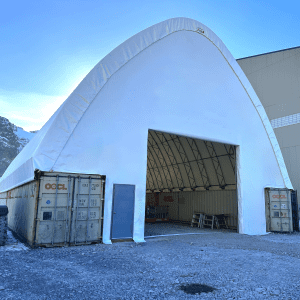How Calhoun Super Structures is Tackling Winter Weather
Is It Cold In Here, January?
Ahhh, January; for most of us it’s a cold, blustery month full of heavy snow and hiding away under a cozy blanket… and with the colder months comes a frequently asked question: is it cold and drafty inside a fabric structure during the winter?
The short answer: no!
 Our structures are all-weather engineered and have been installed in harsh climates, including in Alaska and the Canadian north. One of the benefits of a fabric is thermal non-conductivity, which means that heat exchange between the internal and external environment is dampened. Steel, stone, and concrete will transfer heat rapidly with their environment, making temperature regulation more difficult. Generally, fabric structure interiors will remain up to 20 degrees warmer during the winter and 10-15 degrees cooler during the summer. The energy efficiency of HDPE coverings makes it a cost-effective solution that also provides UV resistance and the ability to withstand temperatures between -148 to 176 degrees Fahrenheit. Other material properties of HDPE membranes include being a highly dense material without holes (or pores), maintaining its physical and mechanical properties at high and low temperatures, having good resistance to stress cracks, and excellent strength against deformation properties.
Our structures are all-weather engineered and have been installed in harsh climates, including in Alaska and the Canadian north. One of the benefits of a fabric is thermal non-conductivity, which means that heat exchange between the internal and external environment is dampened. Steel, stone, and concrete will transfer heat rapidly with their environment, making temperature regulation more difficult. Generally, fabric structure interiors will remain up to 20 degrees warmer during the winter and 10-15 degrees cooler during the summer. The energy efficiency of HDPE coverings makes it a cost-effective solution that also provides UV resistance and the ability to withstand temperatures between -148 to 176 degrees Fahrenheit. Other material properties of HDPE membranes include being a highly dense material without holes (or pores), maintaining its physical and mechanical properties at high and low temperatures, having good resistance to stress cracks, and excellent strength against deformation properties.
For very cold climates, insulation and liners can be added to increase the heat retention of the fabric. Fabric facilities can also be fitted with a range of heating or ventilation products to increase interior comfort.
